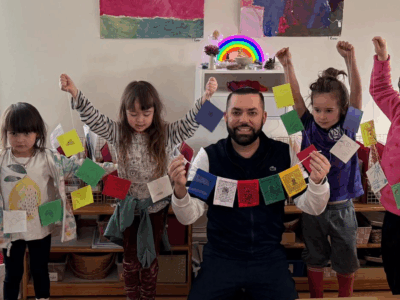How to Practice Metta with Children

About This Resource
Details
How to Practice Metta with Children
By Gail Silver
When I returned home after attending my first silent retreat, I was overflowing with loving-kindness and found myself spontaneously reciting certain phrases of the metta prayer aloud:
May you be happy.
May you be safe.
May you be strong.
May you live with ease.
“Did you just tell me to live with ‘peas’?” my littlest one asked me. “No, honey,” I laughed. “I said, ‘ease.’ May you live with ease.”
Derived from the ancient Pali scriptures, metta translates into English as friendliness or loving-kindness. It’s commonly used to refer to a type of meditation where the practitioner, by reciting specific phrases, wishes herself well-being and then gradually extends that wish to others before offering it universally to all beings everywhere.
Practicing metta enriches our lives by creating a warm-hearted feeling within us, and elevating our capacity for benevolence and compassion. This pleasant effect can be immediate, but more often it arises subtly, manifesting in our everyday life as contentment and a renewed appreciation for other people.
Once we understand metta, we can use it not only to inform and soften our lives but also those of our children.
Select a quiet space, free of distraction, and a time of day when your child is rested, fed, and relatively content. The duration of your practice will vary depending upon the age of your child, but as you progress together, your child’s ability to sit for longer periods may become apparent. Yours may as well.
Sit comfortably on a cushion, chair, or sofa. The intention is for the body to feel at ease and the mind to be alert. Invite your child to close her eyes and feel her breath moving in and out of her body. If she’d like, she can count her breaths. Attending to the breath in this way allows the mind to release distracting thoughts and prepares it for the practice.
Explain that metta is a practice of making wishes for our well-being and for the well-being of others. Tell her that there are four specific phrases and that we begin by reciting them for ourselves.
The first phrase is, “May I be happy.” As she breathes in, suggest that she might like to smile. Breathing out, she can think, “May I be happy.” This does not mean that she has to be happy in this moment. She’s just experimenting with her thoughts, understanding how it feels to wish happiness for herself.
The second phrase is “May I be safe.” Breathing in, she might like to think about something that comforts her: a stuffed animal or a hug from a special grown-up. It’s okay if her mind doesn’t want to latch onto anything too specific. Saying the words is enough. With her exhalation, she can think, “May I be safe.”
The third phrase is “May I be strong.” Strength can be understood as having good health or the courage not to fall down when life doesn’t seem to be going our way. Breathing in, still and steady, your child can visualize herself in whatever way feels good for her, and breathing out, she can think, “May I be strong.”
The final phrase, “May I live with ease,” refers to freedom from suffering in both body and mind. It can be translated for a child as, “May things not be difficult for me, but if they are, may I not have too much difficulty with the difficulty.” Breathing in, she might like to envision a raft, floating effortlessly over waves as they come and go, and breathing out, she can think, “May I live with ease.”
Now, buoyed by good feelings, your child is ready to practice metta for others: someone she loves, a neutral person, a more difficult person, and finally for all beings everywhere. Teach her to recite the same phrases for others that she used for herself.
You might ask your child, “How does practicing metta make you feel?” or “What do you like most about metta?” She may be delighted to discover that in the same way a medicine brings down a fever or a throat lozenge soothes her sore throat, metta can ease the upsets of her inner landscape. Be sure to point out this distinction, though: unlike the top-shelf elixirs of the traditional medicine chest, a healthy dose of “mettacine” is always within her reach.

